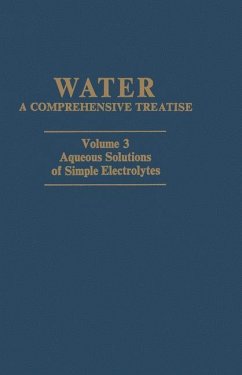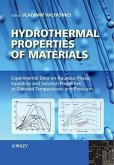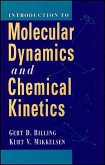Joseph F Zemaitis, Diane M Clark, Marshall Rafal, Noel C Scrivner
Handbook of Aqueous Electrolyte Thermodynamics
Theory & Application
Joseph F Zemaitis, Diane M Clark, Marshall Rafal, Noel C Scrivner
Handbook of Aqueous Electrolyte Thermodynamics
Theory & Application
- Gebundenes Buch
- Merkliste
- Auf die Merkliste
- Bewerten Bewerten
- Teilen
- Produkt teilen
- Produkterinnerung
- Produkterinnerung
Expertise in electrolyte systems has become increasingly important in traditional chemical process industry operations, as well as in oil/gas exploration and production. In particular, electrolyte systems come into play in many important applications involving the environment. Unit recently, engineers faced with the dilemma of predicting the behavior of electrolyte or predicting the behavior of electrolyte systems had to resort to crude predictions largely based on the adaptation of methods applicable to hydrocarbons systems. The Handbook of Aqueous Electrolyte Thermodynamics solves the modern…mehr
Andere Kunden interessierten sich auch für
![An Introduction to Aqueous Electrolyte Solutions An Introduction to Aqueous Electrolyte Solutions]() Margaret Robson WrightAn Introduction to Aqueous Electrolyte Solutions261,99 €
Margaret Robson WrightAn Introduction to Aqueous Electrolyte Solutions261,99 €![Kinetic Theory and Irreversible Thermodynamics Kinetic Theory and Irreversible Thermodynamics]() Byung Chan EuKinetic Theory and Irreversible Thermodynamics497,99 €
Byung Chan EuKinetic Theory and Irreversible Thermodynamics497,99 €![Aqueous Solutions of Simple Electrolytes Aqueous Solutions of Simple Electrolytes]() Felix FranksAqueous Solutions of Simple Electrolytes41,99 €
Felix FranksAqueous Solutions of Simple Electrolytes41,99 €![Adsorption From Aqueous Solutions Adsorption From Aqueous Solutions]() P. H. TewariAdsorption From Aqueous Solutions41,99 €
P. H. TewariAdsorption From Aqueous Solutions41,99 €![Advances in Liquid Crystals Advances in Liquid Crystals]() Advances in Liquid Crystals451,99 €
Advances in Liquid Crystals451,99 €![Hydrothermal Properties of Materials Hydrothermal Properties of Materials]() Hydrothermal Properties of Materials355,99 €
Hydrothermal Properties of Materials355,99 €![Introduction to Molecular Dynamics and Chemical Kinetics & Advanced Molecular Dynamics and Chemical Kinetics, 2 Volume Set Introduction to Molecular Dynamics and Chemical Kinetics & Advanced Molecular Dynamics and Chemical Kinetics, 2 Volume Set]() Gert Due BillingIntroduction to Molecular Dynamics and Chemical Kinetics & Advanced Molecular Dynamics and Chemical Kinetics, 2 Volume Set333,99 €
Gert Due BillingIntroduction to Molecular Dynamics and Chemical Kinetics & Advanced Molecular Dynamics and Chemical Kinetics, 2 Volume Set333,99 €-
-
-
Expertise in electrolyte systems has become increasingly important in traditional chemical process industry operations, as well as in oil/gas exploration and production. In particular, electrolyte systems come into play in many important applications involving the environment. Unit recently, engineers faced with the dilemma of predicting the behavior of electrolyte or predicting the behavior of electrolyte systems had to resort to crude predictions largely based on the adaptation of methods applicable to hydrocarbons systems. The Handbook of Aqueous Electrolyte Thermodynamics solves the modern engineer's dilemma by acting as a "do-it yourself" guide, with a blueprint for formulating predictive mathematical electrolyte models, recommended tabular values to use in these models, and annotated bibliographies. Engineers confronting the task of solving industrial problems may now solve them by turning to the Handbook and applying the compiled available data and/or the data prediction and analysis techniques presented in this volume to the problem at hand. Here, the engineer will find a thorough and systematic presentation of electrolyte thermodynamics, beginning with the basic definitions of the equilibrium constants used in formulating electrolyte models and ending with an exposition and comparison of several of the best formulations for the activity coefficients of strong and/or weak electrolytes. In the final chapter there is a general recipe for formulating complete predictive models for electrolytes along with a series of worked illustrative examples. This unique handbook serves as a useful research and application tool for the practicing process engineer as well as a college textbook for the chemical engineering student.
Hinweis: Dieser Artikel kann nur an eine deutsche Lieferadresse ausgeliefert werden.
Hinweis: Dieser Artikel kann nur an eine deutsche Lieferadresse ausgeliefert werden.
Produktdetails
- Produktdetails
- Verlag: Wiley
- Seitenzahl: 880
- Erscheinungstermin: 15. Juni 1986
- Englisch
- Abmessung: 260mm x 180mm x 46mm
- Gewicht: 1624g
- ISBN-13: 9780816903504
- ISBN-10: 0816903506
- Artikelnr.: 23281602
- Herstellerkennzeichnung
- Libri GmbH
- Europaallee 1
- 36244 Bad Hersfeld
- gpsr@libri.de
- Verlag: Wiley
- Seitenzahl: 880
- Erscheinungstermin: 15. Juni 1986
- Englisch
- Abmessung: 260mm x 180mm x 46mm
- Gewicht: 1624g
- ISBN-13: 9780816903504
- ISBN-10: 0816903506
- Artikelnr.: 23281602
- Herstellerkennzeichnung
- Libri GmbH
- Europaallee 1
- 36244 Bad Hersfeld
- gpsr@libri.de
The late Joseph F. Zemaitis, Jr. was President of Chem Solve, Inc. Prior to the formation of Chem Solve, he was Vice-President of OLI Systems, Inc. Dr. Semaitis worked for 9 years at ESSO Research Engineering as Principal Consultant in fluid dynamics and engineering technology. A graduate of Drexel Tech, he received his M.S. and Ph.D. from Carnegie-Mellon University. He was a Lecturer in Physics at Drew University and Mathematics at the County College of Morris. Dr. Zemaitis was a member of AICHE, ACS and AAPT. Diane M. Clark is presently a Senior Scientist at OLI System, Inc. Prior to this she worked for Chem Solve, Inc. She received a B.S. in Mathematics and Computer Science from Clarkson College of Technology (now Clarkson University) and is a member of AICHE. Marshal Rafal is President and founder of OLI Systems, Inc. a world leader in computer software for simulation of aqueous chemistry. Prior to founding OLI in 1971, Dr. Rafal worked at ESSO Mathematics and Systems, Inc. for five years. He received a B.Ch.E. from the Cooper Union and an M.S. Ch.E. and Ph.D. from Northwestern University. Dr. Rafal is a member of AICHE. Noel C. Scrivner, as a Senior Consultant at the Du Pont Company, consults on the problems of thermodynamics and kinetics company-wide. His current interest is in the application of electrolyte thermodynamics to geochemistry problems. He received a B.A. and a B.S. from Rice University and an M.S. and Ph.D. from Carnegie-Mellon University-all in Chemical Engineering. He is currently chairman of the Design Institute for Physical Property Data (DIPPR) Aqueous Electrolyte Thermodynamic Database project. He is member of AICHE, ACS, Sigma Xi, and American Geophysical Union.
I. INTRODUCTION. II. THERMODYNAMICS OF SOLUTIONS. Basic Thermodynamic Functions. Solutions - Basic Definitions and Concepts. Equilibrium - Necessary Conditions. Activities, Activity Coefficients and Standard States. III. EQUILIBRIUM CONSTANTS. Ionic and/or Reaction Equilibrium in Aqueous Solutions. Solubility Equilibria Between Crystals and Saturated Solutions. Vapor-Liquid Equilibria in Aqueous Solutions. Temperature Effects on the Equilibrium Constant. Estimating Temperature Effects on Heat Capacity and Other Thermodynamic Properties. Equilibrium Constants from Tabulated Data. Pressure Effects on the Equilibrium Constant. Appendix 3.1 - Criss and Cobble Parameters. IV. ACTIVITY COEFFICIENTS OF SINGLE STRONG ELECTROLYTES. History. Bromley's Method. Meissner's Method. Pitzer's Method. Chen's Method. Temperature Effects. Application. Bromley's Extended Equation. Comparison of Temperature Effect Methods. Appendix 4.1 - Values for Guggenheim's ß Parameter. Table 1: ß Values for Uni-univalent Electrolytes. Table 2: ß and B Values of Bi-univalent and Uni-bivalent Electrolytes from Freezing Points. Methods for Calculating ß. Appendix 4.2 - Bromley Interaction Parameters. Table 1: B Values at 25°C Determined by the Method of Least Squares on Log
to I=6.0 (or less of limited data). Table 2: Individual Ion Values of B and
in Aqueous Solutions at 25°C. Table 3: Bivalent Metal Sulfates at 25°C. Appendix 4.4 - Pitzer Parameters, Table 1: Inorganic Acids, Bases and Salts of 1-1 Type. Table 2: Salts of Carboxylic Acids (1-1 Type). Table 3: Tetraalkylammonium Halides. Table 4: Sulfonic Acids and Salts (1-1 Type). Table 5: Additional 1-1 Type Organic Salts. Table 6: Inorganic Compounds of 2-1 Type. Table 7: Organic Electrolytes of 2-1 Type. Table 8: 3-1 Electrolytes. Table 9: 4-1 Electrolytes. Table 10: 5-1 Electrolytes. Table 11: 2-2 Electrolytes. Appendix 4.5 - Pitzer Parameter Derivatives. Table 1: Temperature Derivatives of Parameters for 1-1 Electrolytes Evaluated from Calorimetric Data. Table 2: Temperature Derivatives of Parameters for 2-1 and 1-2 Electrolytes Evaluated from Calorimetric Data. Table 3: Temperature Derivatives of Parameters for 3-1 and 2-2 Electrolytes Evaluated from Calorimetric Parameters. Appendix 4-6 Chen Parameters. Table:
Values Fit for Molality Mean Ionic Activity Coefficient Data of Aqueous Electrolytes at 298.15 K. V. ACTIVITY COEFFICIENTS OF MULTICOMPONET STRONG ELECTROLYTES. Guggenheim's Method for Multicomponent Solutions. Bromley's Method for Multicomponent Solutions. Meissner's Method for Multicomponent Solutions. Pitzer's Method for Multicomponent Solutions. Application. Phase Diagram Calculations. Appendix 5.1 - Values for Pitzer's
and
Parameters. Table 1: Parameters for mixed electrolytes with viral coefficient equations (at 25°C). Table 2: Parameters for the viral coefficient equations at 25°C, Table 3: Parameters for binary mixtures with a common ion at 25°C. VI. ACTIVITY COEFFICIENT OF STRONGLY COMPLEXING COMPOUNDS. Identification of Complexing Electrolytes. Phosphoric Acid. Sulfuric Acid. Zinc Chloride. Ferric Chloride. Cuprous Chloride. Calcium Sulfate. Sodium Sulfate. Other Chloride Complexes. Activity Coefficient Methods. Summary. Appendix 6.1 Cuprous Chloride. Table 1a: Interaction Parameters. Table 1b: Three Parameter Set. Table 2: Equilibrium Constants and Heats of Reaction. Table 3a: Equilibrium Constants and Changes in Thermodynamic Properties for Formation of CuC1¯ and CuC1²¯ from CuC1(s) + nC1¯ = CuC1 Table 3b: Equilibrium Constants and Changes in Thermodynamic Properties for Formation of CuC1¯ and CuC1²¯ from Cu+ + nC1¯ = CuC1n(n-1. VII. ACTIVITY COEFFICIENTS OF WEAK ELECTROLYTES AND MOLECULAR SPECIES. Setschénow Equation. Pitzer Based Equations. Predictions Based Upon Theoretical Equations. Appendix 7.1 - Salting Out Parameters for Phenol in Aqueous Salt Solutions at 25°C Celsius. Appendix 7.2 - Salting Out Parameters from Pawlikowski and Prausnitz for Nonpolar Gases in Common Salt Solutions at Moderate Temperatures. Table 1: Lennard - Jones Parameters for Nonpolar Gases as Reported by Liabastre (S14). Table 2: Salting Out Parameters for Strong Electrolytes in Equation (7.18) at 25°C. Table 3: Temperature Dependence of the Salting Out Parameters for Equation (7.19). Table 4: Salting Out Parameters for Individual Ions for Equation (7.20). Table 5: Temperature Dependence of the Salting Out Constants for Individual Loss. VIII. THERMODYNAMIC FUNCTIONS DERIVED FROM ACTIVITY COEFFICIENTS. Density. Enthalpy. Excess Enthalpy. Example. IX. WORKED EXAMPLES. Model Formulation. Obtaining Coefficients. Model Solution. Specific Examples. Appendix 9.1 - Parameters for Beutier and Renon's Method. Table 1: Temperature fit parameters for equilibrium constants. Table 2: Temperature fit parameters for Henry's constants. Table 3: Pitzer ion-ion interaction parameters. Table 4: Temperature fit molecule self interaction parameters. Table 5: Dielectric effect parameters. Appendix 9.2- Parameters for Edwards, Maurer, Newman and Prausnitz Method. Table 1: Temperature fit parameters for equilibrium constants. Table 2: Temperature fit parameters for Henry's constants. Table 3: Ion-ion interaction parameters. Table 4: Temperature fit molecule self interaction parameters. Table 5: Molecule-ion interaction parameters. Appendix 9.3 - Fugacity Coefficient Calculation. Table 1: Pure component parameters. Table 2: Nonpolar and polar contribution to parameters α and β for four polar gases. Table 3: Interaction parameter α12 for polar-nonpolar mixtures. Table 4: Parameterα12 for binary mixtures of nonpolar gases. Table 5: Interaction parameter α12 for polar-polar mixtures. Appendix 9.4 - Brelvi and O'Connell Correlation for Partial Molar Volumes. Table 1: Characteristic Volumes. Appendix 9.5 - Gypsum Solubility Study Parameters at 25°C. Table 1: Binary solution parameters for the Pitzer equations. Table 2: Mixed electrolyte solution parameters for the Pitzer equations. Table 3: Gypsum solubility product at 25°C. Appendix A. Computer Programs for Solving Equilibria Problems. Appendix B. Selected Thermodynamic Data. Appendix C. Compiled Thermodynamic Data Sources for Aqueous and Biochemical Systems: An Annotated Bibliography (1930-1983). Index.
to I=6.0 (or less of limited data). Table 2: Individual Ion Values of B and
in Aqueous Solutions at 25°C. Table 3: Bivalent Metal Sulfates at 25°C. Appendix 4.4 - Pitzer Parameters, Table 1: Inorganic Acids, Bases and Salts of 1-1 Type. Table 2: Salts of Carboxylic Acids (1-1 Type). Table 3: Tetraalkylammonium Halides. Table 4: Sulfonic Acids and Salts (1-1 Type). Table 5: Additional 1-1 Type Organic Salts. Table 6: Inorganic Compounds of 2-1 Type. Table 7: Organic Electrolytes of 2-1 Type. Table 8: 3-1 Electrolytes. Table 9: 4-1 Electrolytes. Table 10: 5-1 Electrolytes. Table 11: 2-2 Electrolytes. Appendix 4.5 - Pitzer Parameter Derivatives. Table 1: Temperature Derivatives of Parameters for 1-1 Electrolytes Evaluated from Calorimetric Data. Table 2: Temperature Derivatives of Parameters for 2-1 and 1-2 Electrolytes Evaluated from Calorimetric Data. Table 3: Temperature Derivatives of Parameters for 3-1 and 2-2 Electrolytes Evaluated from Calorimetric Parameters. Appendix 4-6 Chen Parameters. Table:
Values Fit for Molality Mean Ionic Activity Coefficient Data of Aqueous Electrolytes at 298.15 K. V. ACTIVITY COEFFICIENTS OF MULTICOMPONET STRONG ELECTROLYTES. Guggenheim's Method for Multicomponent Solutions. Bromley's Method for Multicomponent Solutions. Meissner's Method for Multicomponent Solutions. Pitzer's Method for Multicomponent Solutions. Application. Phase Diagram Calculations. Appendix 5.1 - Values for Pitzer's
and
Parameters. Table 1: Parameters for mixed electrolytes with viral coefficient equations (at 25°C). Table 2: Parameters for the viral coefficient equations at 25°C, Table 3: Parameters for binary mixtures with a common ion at 25°C. VI. ACTIVITY COEFFICIENT OF STRONGLY COMPLEXING COMPOUNDS. Identification of Complexing Electrolytes. Phosphoric Acid. Sulfuric Acid. Zinc Chloride. Ferric Chloride. Cuprous Chloride. Calcium Sulfate. Sodium Sulfate. Other Chloride Complexes. Activity Coefficient Methods. Summary. Appendix 6.1 Cuprous Chloride. Table 1a: Interaction Parameters. Table 1b: Three Parameter Set. Table 2: Equilibrium Constants and Heats of Reaction. Table 3a: Equilibrium Constants and Changes in Thermodynamic Properties for Formation of CuC1¯ and CuC1²¯ from CuC1(s) + nC1¯ = CuC1 Table 3b: Equilibrium Constants and Changes in Thermodynamic Properties for Formation of CuC1¯ and CuC1²¯ from Cu+ + nC1¯ = CuC1n(n-1. VII. ACTIVITY COEFFICIENTS OF WEAK ELECTROLYTES AND MOLECULAR SPECIES. Setschénow Equation. Pitzer Based Equations. Predictions Based Upon Theoretical Equations. Appendix 7.1 - Salting Out Parameters for Phenol in Aqueous Salt Solutions at 25°C Celsius. Appendix 7.2 - Salting Out Parameters from Pawlikowski and Prausnitz for Nonpolar Gases in Common Salt Solutions at Moderate Temperatures. Table 1: Lennard - Jones Parameters for Nonpolar Gases as Reported by Liabastre (S14). Table 2: Salting Out Parameters for Strong Electrolytes in Equation (7.18) at 25°C. Table 3: Temperature Dependence of the Salting Out Parameters for Equation (7.19). Table 4: Salting Out Parameters for Individual Ions for Equation (7.20). Table 5: Temperature Dependence of the Salting Out Constants for Individual Loss. VIII. THERMODYNAMIC FUNCTIONS DERIVED FROM ACTIVITY COEFFICIENTS. Density. Enthalpy. Excess Enthalpy. Example. IX. WORKED EXAMPLES. Model Formulation. Obtaining Coefficients. Model Solution. Specific Examples. Appendix 9.1 - Parameters for Beutier and Renon's Method. Table 1: Temperature fit parameters for equilibrium constants. Table 2: Temperature fit parameters for Henry's constants. Table 3: Pitzer ion-ion interaction parameters. Table 4: Temperature fit molecule self interaction parameters. Table 5: Dielectric effect parameters. Appendix 9.2- Parameters for Edwards, Maurer, Newman and Prausnitz Method. Table 1: Temperature fit parameters for equilibrium constants. Table 2: Temperature fit parameters for Henry's constants. Table 3: Ion-ion interaction parameters. Table 4: Temperature fit molecule self interaction parameters. Table 5: Molecule-ion interaction parameters. Appendix 9.3 - Fugacity Coefficient Calculation. Table 1: Pure component parameters. Table 2: Nonpolar and polar contribution to parameters α and β for four polar gases. Table 3: Interaction parameter α12 for polar-nonpolar mixtures. Table 4: Parameterα12 for binary mixtures of nonpolar gases. Table 5: Interaction parameter α12 for polar-polar mixtures. Appendix 9.4 - Brelvi and O'Connell Correlation for Partial Molar Volumes. Table 1: Characteristic Volumes. Appendix 9.5 - Gypsum Solubility Study Parameters at 25°C. Table 1: Binary solution parameters for the Pitzer equations. Table 2: Mixed electrolyte solution parameters for the Pitzer equations. Table 3: Gypsum solubility product at 25°C. Appendix A. Computer Programs for Solving Equilibria Problems. Appendix B. Selected Thermodynamic Data. Appendix C. Compiled Thermodynamic Data Sources for Aqueous and Biochemical Systems: An Annotated Bibliography (1930-1983). Index.
I. INTRODUCTION. II. THERMODYNAMICS OF SOLUTIONS. Basic Thermodynamic Functions. Solutions - Basic Definitions and Concepts. Equilibrium - Necessary Conditions. Activities, Activity Coefficients and Standard States. III. EQUILIBRIUM CONSTANTS. Ionic and/or Reaction Equilibrium in Aqueous Solutions. Solubility Equilibria Between Crystals and Saturated Solutions. Vapor-Liquid Equilibria in Aqueous Solutions. Temperature Effects on the Equilibrium Constant. Estimating Temperature Effects on Heat Capacity and Other Thermodynamic Properties. Equilibrium Constants from Tabulated Data. Pressure Effects on the Equilibrium Constant. Appendix 3.1 - Criss and Cobble Parameters. IV. ACTIVITY COEFFICIENTS OF SINGLE STRONG ELECTROLYTES. History. Bromley's Method. Meissner's Method. Pitzer's Method. Chen's Method. Temperature Effects. Application. Bromley's Extended Equation. Comparison of Temperature Effect Methods. Appendix 4.1 - Values for Guggenheim's ß Parameter. Table 1: ß Values for Uni-univalent Electrolytes. Table 2: ß and B Values of Bi-univalent and Uni-bivalent Electrolytes from Freezing Points. Methods for Calculating ß. Appendix 4.2 - Bromley Interaction Parameters. Table 1: B Values at 25°C Determined by the Method of Least Squares on Log
to I=6.0 (or less of limited data). Table 2: Individual Ion Values of B and
in Aqueous Solutions at 25°C. Table 3: Bivalent Metal Sulfates at 25°C. Appendix 4.4 - Pitzer Parameters, Table 1: Inorganic Acids, Bases and Salts of 1-1 Type. Table 2: Salts of Carboxylic Acids (1-1 Type). Table 3: Tetraalkylammonium Halides. Table 4: Sulfonic Acids and Salts (1-1 Type). Table 5: Additional 1-1 Type Organic Salts. Table 6: Inorganic Compounds of 2-1 Type. Table 7: Organic Electrolytes of 2-1 Type. Table 8: 3-1 Electrolytes. Table 9: 4-1 Electrolytes. Table 10: 5-1 Electrolytes. Table 11: 2-2 Electrolytes. Appendix 4.5 - Pitzer Parameter Derivatives. Table 1: Temperature Derivatives of Parameters for 1-1 Electrolytes Evaluated from Calorimetric Data. Table 2: Temperature Derivatives of Parameters for 2-1 and 1-2 Electrolytes Evaluated from Calorimetric Data. Table 3: Temperature Derivatives of Parameters for 3-1 and 2-2 Electrolytes Evaluated from Calorimetric Parameters. Appendix 4-6 Chen Parameters. Table:
Values Fit for Molality Mean Ionic Activity Coefficient Data of Aqueous Electrolytes at 298.15 K. V. ACTIVITY COEFFICIENTS OF MULTICOMPONET STRONG ELECTROLYTES. Guggenheim's Method for Multicomponent Solutions. Bromley's Method for Multicomponent Solutions. Meissner's Method for Multicomponent Solutions. Pitzer's Method for Multicomponent Solutions. Application. Phase Diagram Calculations. Appendix 5.1 - Values for Pitzer's
and
Parameters. Table 1: Parameters for mixed electrolytes with viral coefficient equations (at 25°C). Table 2: Parameters for the viral coefficient equations at 25°C, Table 3: Parameters for binary mixtures with a common ion at 25°C. VI. ACTIVITY COEFFICIENT OF STRONGLY COMPLEXING COMPOUNDS. Identification of Complexing Electrolytes. Phosphoric Acid. Sulfuric Acid. Zinc Chloride. Ferric Chloride. Cuprous Chloride. Calcium Sulfate. Sodium Sulfate. Other Chloride Complexes. Activity Coefficient Methods. Summary. Appendix 6.1 Cuprous Chloride. Table 1a: Interaction Parameters. Table 1b: Three Parameter Set. Table 2: Equilibrium Constants and Heats of Reaction. Table 3a: Equilibrium Constants and Changes in Thermodynamic Properties for Formation of CuC1¯ and CuC1²¯ from CuC1(s) + nC1¯ = CuC1 Table 3b: Equilibrium Constants and Changes in Thermodynamic Properties for Formation of CuC1¯ and CuC1²¯ from Cu+ + nC1¯ = CuC1n(n-1. VII. ACTIVITY COEFFICIENTS OF WEAK ELECTROLYTES AND MOLECULAR SPECIES. Setschénow Equation. Pitzer Based Equations. Predictions Based Upon Theoretical Equations. Appendix 7.1 - Salting Out Parameters for Phenol in Aqueous Salt Solutions at 25°C Celsius. Appendix 7.2 - Salting Out Parameters from Pawlikowski and Prausnitz for Nonpolar Gases in Common Salt Solutions at Moderate Temperatures. Table 1: Lennard - Jones Parameters for Nonpolar Gases as Reported by Liabastre (S14). Table 2: Salting Out Parameters for Strong Electrolytes in Equation (7.18) at 25°C. Table 3: Temperature Dependence of the Salting Out Parameters for Equation (7.19). Table 4: Salting Out Parameters for Individual Ions for Equation (7.20). Table 5: Temperature Dependence of the Salting Out Constants for Individual Loss. VIII. THERMODYNAMIC FUNCTIONS DERIVED FROM ACTIVITY COEFFICIENTS. Density. Enthalpy. Excess Enthalpy. Example. IX. WORKED EXAMPLES. Model Formulation. Obtaining Coefficients. Model Solution. Specific Examples. Appendix 9.1 - Parameters for Beutier and Renon's Method. Table 1: Temperature fit parameters for equilibrium constants. Table 2: Temperature fit parameters for Henry's constants. Table 3: Pitzer ion-ion interaction parameters. Table 4: Temperature fit molecule self interaction parameters. Table 5: Dielectric effect parameters. Appendix 9.2- Parameters for Edwards, Maurer, Newman and Prausnitz Method. Table 1: Temperature fit parameters for equilibrium constants. Table 2: Temperature fit parameters for Henry's constants. Table 3: Ion-ion interaction parameters. Table 4: Temperature fit molecule self interaction parameters. Table 5: Molecule-ion interaction parameters. Appendix 9.3 - Fugacity Coefficient Calculation. Table 1: Pure component parameters. Table 2: Nonpolar and polar contribution to parameters α and β for four polar gases. Table 3: Interaction parameter α12 for polar-nonpolar mixtures. Table 4: Parameterα12 for binary mixtures of nonpolar gases. Table 5: Interaction parameter α12 for polar-polar mixtures. Appendix 9.4 - Brelvi and O'Connell Correlation for Partial Molar Volumes. Table 1: Characteristic Volumes. Appendix 9.5 - Gypsum Solubility Study Parameters at 25°C. Table 1: Binary solution parameters for the Pitzer equations. Table 2: Mixed electrolyte solution parameters for the Pitzer equations. Table 3: Gypsum solubility product at 25°C. Appendix A. Computer Programs for Solving Equilibria Problems. Appendix B. Selected Thermodynamic Data. Appendix C. Compiled Thermodynamic Data Sources for Aqueous and Biochemical Systems: An Annotated Bibliography (1930-1983). Index.
to I=6.0 (or less of limited data). Table 2: Individual Ion Values of B and
in Aqueous Solutions at 25°C. Table 3: Bivalent Metal Sulfates at 25°C. Appendix 4.4 - Pitzer Parameters, Table 1: Inorganic Acids, Bases and Salts of 1-1 Type. Table 2: Salts of Carboxylic Acids (1-1 Type). Table 3: Tetraalkylammonium Halides. Table 4: Sulfonic Acids and Salts (1-1 Type). Table 5: Additional 1-1 Type Organic Salts. Table 6: Inorganic Compounds of 2-1 Type. Table 7: Organic Electrolytes of 2-1 Type. Table 8: 3-1 Electrolytes. Table 9: 4-1 Electrolytes. Table 10: 5-1 Electrolytes. Table 11: 2-2 Electrolytes. Appendix 4.5 - Pitzer Parameter Derivatives. Table 1: Temperature Derivatives of Parameters for 1-1 Electrolytes Evaluated from Calorimetric Data. Table 2: Temperature Derivatives of Parameters for 2-1 and 1-2 Electrolytes Evaluated from Calorimetric Data. Table 3: Temperature Derivatives of Parameters for 3-1 and 2-2 Electrolytes Evaluated from Calorimetric Parameters. Appendix 4-6 Chen Parameters. Table:
Values Fit for Molality Mean Ionic Activity Coefficient Data of Aqueous Electrolytes at 298.15 K. V. ACTIVITY COEFFICIENTS OF MULTICOMPONET STRONG ELECTROLYTES. Guggenheim's Method for Multicomponent Solutions. Bromley's Method for Multicomponent Solutions. Meissner's Method for Multicomponent Solutions. Pitzer's Method for Multicomponent Solutions. Application. Phase Diagram Calculations. Appendix 5.1 - Values for Pitzer's
and
Parameters. Table 1: Parameters for mixed electrolytes with viral coefficient equations (at 25°C). Table 2: Parameters for the viral coefficient equations at 25°C, Table 3: Parameters for binary mixtures with a common ion at 25°C. VI. ACTIVITY COEFFICIENT OF STRONGLY COMPLEXING COMPOUNDS. Identification of Complexing Electrolytes. Phosphoric Acid. Sulfuric Acid. Zinc Chloride. Ferric Chloride. Cuprous Chloride. Calcium Sulfate. Sodium Sulfate. Other Chloride Complexes. Activity Coefficient Methods. Summary. Appendix 6.1 Cuprous Chloride. Table 1a: Interaction Parameters. Table 1b: Three Parameter Set. Table 2: Equilibrium Constants and Heats of Reaction. Table 3a: Equilibrium Constants and Changes in Thermodynamic Properties for Formation of CuC1¯ and CuC1²¯ from CuC1(s) + nC1¯ = CuC1 Table 3b: Equilibrium Constants and Changes in Thermodynamic Properties for Formation of CuC1¯ and CuC1²¯ from Cu+ + nC1¯ = CuC1n(n-1. VII. ACTIVITY COEFFICIENTS OF WEAK ELECTROLYTES AND MOLECULAR SPECIES. Setschénow Equation. Pitzer Based Equations. Predictions Based Upon Theoretical Equations. Appendix 7.1 - Salting Out Parameters for Phenol in Aqueous Salt Solutions at 25°C Celsius. Appendix 7.2 - Salting Out Parameters from Pawlikowski and Prausnitz for Nonpolar Gases in Common Salt Solutions at Moderate Temperatures. Table 1: Lennard - Jones Parameters for Nonpolar Gases as Reported by Liabastre (S14). Table 2: Salting Out Parameters for Strong Electrolytes in Equation (7.18) at 25°C. Table 3: Temperature Dependence of the Salting Out Parameters for Equation (7.19). Table 4: Salting Out Parameters for Individual Ions for Equation (7.20). Table 5: Temperature Dependence of the Salting Out Constants for Individual Loss. VIII. THERMODYNAMIC FUNCTIONS DERIVED FROM ACTIVITY COEFFICIENTS. Density. Enthalpy. Excess Enthalpy. Example. IX. WORKED EXAMPLES. Model Formulation. Obtaining Coefficients. Model Solution. Specific Examples. Appendix 9.1 - Parameters for Beutier and Renon's Method. Table 1: Temperature fit parameters for equilibrium constants. Table 2: Temperature fit parameters for Henry's constants. Table 3: Pitzer ion-ion interaction parameters. Table 4: Temperature fit molecule self interaction parameters. Table 5: Dielectric effect parameters. Appendix 9.2- Parameters for Edwards, Maurer, Newman and Prausnitz Method. Table 1: Temperature fit parameters for equilibrium constants. Table 2: Temperature fit parameters for Henry's constants. Table 3: Ion-ion interaction parameters. Table 4: Temperature fit molecule self interaction parameters. Table 5: Molecule-ion interaction parameters. Appendix 9.3 - Fugacity Coefficient Calculation. Table 1: Pure component parameters. Table 2: Nonpolar and polar contribution to parameters α and β for four polar gases. Table 3: Interaction parameter α12 for polar-nonpolar mixtures. Table 4: Parameterα12 for binary mixtures of nonpolar gases. Table 5: Interaction parameter α12 for polar-polar mixtures. Appendix 9.4 - Brelvi and O'Connell Correlation for Partial Molar Volumes. Table 1: Characteristic Volumes. Appendix 9.5 - Gypsum Solubility Study Parameters at 25°C. Table 1: Binary solution parameters for the Pitzer equations. Table 2: Mixed electrolyte solution parameters for the Pitzer equations. Table 3: Gypsum solubility product at 25°C. Appendix A. Computer Programs for Solving Equilibria Problems. Appendix B. Selected Thermodynamic Data. Appendix C. Compiled Thermodynamic Data Sources for Aqueous and Biochemical Systems: An Annotated Bibliography (1930-1983). Index.








